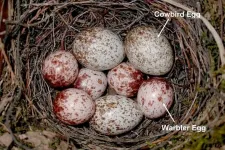(Press-News.org) ITHACA, N.Y. - Research shows people turn to religion in times of fear and uncertainty - and March 2020 was one of those times.
To find the impact of religion during the early days of the COVID-19 pandemic in the United States, Landon Schnabel, the Robert and Ann Rosenthal Assistant Professor of Sociology in the College of Arts and Sciences, analyzed responses from 11,537 Americans surveyed March 19-24, 2020, shortly after the World Health Organization declared COVID-19 a global health pandemic.
Religion protected mental health of members of several faith groups, Schnabel reports in the Journal for the Scientific Study of Religion, but also constrained crisis response among some of the same groups, ultimately undercutting the overall effectiveness of public health efforts to contain the virus.
"Religion limited the negative mental health impacts of the COVID-19 pandemic in March, with highly religious Americans and especially evangelicals experiencing less distress than more secular Americans," Schnabel wrote. "However, that mental health benefit came at the cost of less concern about and support for addressing an important real-world problem: saving lives during a pandemic."
According to Schnabel, "the most obvious explanation for this pattern is the politicization of the pandemic and the fact that ... Republicans and conservatives simply were not as concerned about the pandemic and less likely to think they needed to worry about social distancing, etc."
Intensely religious white people tend to hold conservative values and embrace Republican politics, Schnabel wrote - the same political positions that downplayed the threat of the virus, especially in the early days of the pandemic.
Schnabel based his conclusions on data from Pew Research's American Trends Panel (ATP), made available by the Cornell Roper Center for Public Opinion Research as part of a growing collection of public opinion data related to COVID-19.
The survey asked questions about mental distress, perceived health and economic threats posed by the pandemic, and opinions on public health restrictions and social distancing behaviors. It also collected data about religious affiliation and behavior, and about political party affiliation.
Schnabel's analysis confirmed a documented benefit of religion: increased mental health.
"Regularly attending and evangelical Americans did not experience as much increased distress during the early stages of COVID-19 as Americans who attended less regularly or who were not evangelical," he wrote. "This suggests that religion, typically implicated in rates of distress, mitigated the increased anxiety most Americans were feeling in the early days of the pandemic."
Schnabel's analysis also confirmed previous research documenting the close alignment of religion and politics in the U.S. "In the contemporary United States, religion has become politicized and is now viewed as entangled with conservative politics," he wrote.
"In sum, religion therefore could paradoxically buffer the hardship caused by the pandemic yet structure attitudes and orientations about public health and science in ways that ultimately increase it," Schnabel wrote.
It is within the power of religious people and faith organizations to glean mental health benefits of religion without endangering public health, Schnabel said.
"Religious organizations should consider how they can promote the things that are helpful for mental health and not promote anything harmful for physical health," Schnabel said, such as building community through virtual gatherings and providing virtual tools to provide psychological resources without risk of exposure. "The ideal scenario would be to figure out how to get the mental health benefits while avoiding the things that were unhelpful for containing the pandemic," he said.
The data for this study came from early in the pandemic, Schnabel wrote. "It remains to be seen the exact extent to which religion will continue to protect mental health as we enter the second year of the pandemic."
INFORMATION:
Image inpainting is a computer vision technique in which pixels missing from an image are filled in. It is often used to remove unwanted objects from an image or to recreate missing regions of occluded images. Inpainting is a common tool for predicting missing image data, but it's challenging to synthesize the missing pixels in a realistic and coherent way.
Researchers at the University of Tokyo have presented a frequency-based inpainting method that enables the use of both frequency and spatial information to generate missing image portions. Publishing in the Journal of Electronic Imaging (JEI), Hiya Roy et al. detail the technique in " END ...
COLUMBUS, Ohio - It's one thing to decide among two or three snacks available at a friend's house. But what do people do when they're faced with a vending machine offering 36 different options?
A new study using eye-tracking technology suggests that the amount of time people spend looking at individual items may actually help them decide. Findings showed that people tended to choose snacks they spent more time looking at, sometimes even over snacks that they rated more highly.
"We could do pretty well predicting what people would choose based just ...
CHAMPAIGN, Ill. -- Avian brood parasites lay their eggs in the nests of other bird species, forcing the hosts to do the hard work of raising the unrelated young. A team of scientists wanted to simulate the task of piercing an egg - a tactic that only a minority of host birds use to help grasp and eject the foreign eggs. Their study offers insight into some of the physical challenges the discriminating host birds face.
The new findings appear in the Journal of Experimental Biology.
Take cowbirds, for example. Their eggs look nothing like the host birds' eggs, "yet most of their hosts do not reject the parasite eggs," said study co-author Mark Hauber, a professor of evolution, ecology and behavior at the ...
Natural disasters have a way of bringing people together to rebuild. Now, researchers reporting in the journal Current Biology on April 8 have found that the same is true for rhesus macaques.
The study reports that after a major hurricane hit Puerto Rico, macaques living on Cayo Santiago Island became more tolerant of each other and sought new social connections. The findings are based on careful study of social connections among Cayo Santiago Island's macaques before and after Hurricane Maria, a devastating storm that left more than 3,000 people dead.
"The macaques ...
Chest beating by mountain gorillas - rapidly beating their chests with their hands to produce a drumming sound - may convey information about their body size and allow identification of individuals, a study published in Scientific Reports suggests. These findings demonstrate how non-vocal behaviours may contribute to mountain gorilla communication.
Although it had previously been suggested that gorillas may beat their chests to convey information, the exact nature of that information was unclear. Edward Wright and colleagues observed and recorded 25 wild, adult male silverback gorillas monitored by the Dian Fossey Gorilla Fund in Volcanoes National Park, Rwanda, between January 2014 and July 2016. Body size was determined from photographs ...
Along the Tian Shan and Alay mountain ranges of Central Asia, sheep and other domestic livestock form the core economy of contemporary life. Although it was here that the movements of their ancient predecessors helped to shape the great trade networks of the Silk Road, domestic animals were thought to have come relatively late to the region. A new study, published today in the journal Nature: Human Behavior, reveals that the roots of animal domestication in Central Asia stretch back at least 8,000 years - making the region one of the oldest continuously inhabited pastoral landscapes in the world.
The domestication ...
Ageing and age-related brain disease do not affect women and men in the same way. The adult brain constantly generates new brain cells called neurons from stem cells, a process called neurogenesis. This process is important for learning and cognitive function which declines as the brain ages. Neurogenesis has been extensively studied in animals, but most studies have looked at male animals, raising the question of whether age-related decline in neurogenesis affects both sexes in the same way. To address this, researchers Sally Temple, PhD (sallytemple@neuralsci.org), Kristen Zuloga, PhD (zuloagk@amc.edu) and colleagues at the NY Neural Stem ...
Mutations in the DNA of the cell's energy 'factories' increases the chances of survival for people with bowel cancer, according to a study published today (Thursday) in Nature Metabolism.
Scientists funded by Cancer Research UK have found that patients with colorectal cancer, a common form of bowel cancer, had a 57 to 93% decreased risk of death from their cancer, depending on the presence and type of mitochondrial DNA mutations in their tumours.
The researchers hope that in the future, doctors could use this information to identify patients with more aggressive forms of bowel ...
What The Study Did: This analysis evaluated in-hospital mortality rates for patients with SARS-CoV-2 infection over time and factors associated with changes were examined
Authors: Lyn Finelli, Dr.P.H., M.S., of Merck Research Labs in North Wales, Pennsylvania, is the corresponding author.
To access the embargoed study: Visit our For The Media website at this link https://media.jamanetwork.com/
(doi:10.1001/jamanetworkopen.2021.6556)
Editor's Note: The article includes conflict of interest and funding/support disclosures. Please see the article for additional information, including other authors, author contributions ...
Gorillas usually stand bipedally and rapidly beat their chests with cupped hands in rapid succession. Chest beating is a unique sound because is it not a vocalization, like frogs croaking, but rather it is a form of gestural communication that can be both heard and seen. The emanating drumming sound can be heard over one kilometre away. The presumed function of gorilla chest beats is to attract females and intimidate rival males.
Researchers recorded chest beats and used a technique called photogrammetry to non-invasively measured body size of adult male wild mountain gorillas monitored by the Dian Fossey Gorilla Fund in Volcanoes National Park, Rwanda. They found that larger males emitted chest beats with lower peak frequencies than smaller ones. In other words, ...





